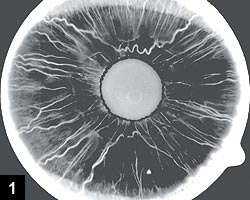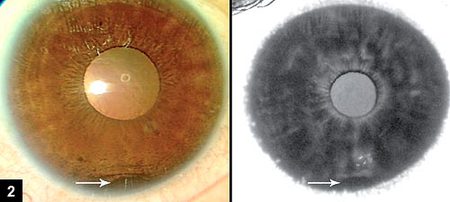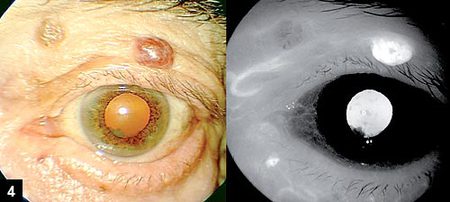Clinicians explain how to perform, interpret anterior segment fluorescein angiography
This technique can be used to study conjunctival vascularization and eye lesions.
Introduction
 Amar Agarwal |

Different systems can be used for anterior segment angiography. Photographic slit lamps provide excellent images, but they need special adjustments, powerful flash units and angiographic filters. They usually lack a timer to visualize the time sequence of the images. Modified early fundus cameras and more recent ones without special modifications can also be used. My special guests in this column are Pablo Gili, MD, of Fundación Hospital Alcorcón in Madrid, and Guillermo Simon-Castellvi, MD,of Simón Eye Clinic in Barcelona, who will explain more on anterior segment angiography.
Amar Agarwal, MS, FRCS, FRCOphth
OSN Complications Consult Editor
One can use a Zeiss FF450 plus fundus camera, Visupac capture software and a Kodak Megaplus 1.6i video camera for anterior segment fluorescein angiography. This permits fluorescein and indocyanine green angiography. One can also perform gonioangiography (angiography of the anterior chamber angle). Indocyanine green iris angiography with the scanning laser ophthalmoscope (eg, SLO, Heidelberg Engineering HRA) compensates for some of the limitations of fluorescein angiography, as the infrared wavelength of the laser deeply penetrates into the pigmented iris tissue, therefore allowing better visualization of fluorescence of iris vessels.
Procedure
The procedure for anterior segment angiography is virtually the same as for retinal angiography: 0.6 mL of sodium fluorescein (10% to 20%) is rapidly injected intravenously, and exciter (blue) and barrier (green-yellow) filters are used in the same way. Adverse effects and the need for informed consent are the same as for retinal angiography. The eyelids must be opened as wide as possible to avoid shadows from the lids on the angiogram. Focus must be done in the anterior segment, which is not always possible with some retinal angiographers, using either positive lenses (eg, adding a +10 D macro lens in front of the retinal camera) or continuous system focusing while moving the body of the camera backward (far from the patient and close to the examiner). Dye appears in the arteries 8 seconds to 20 seconds after injection.
The first images are taken about 8 seconds to 10 seconds after fluorescein injection, and serial photographs are taken for up to 1 minute after injection; late photographs are taken 5 to 10 minutes after injection. In iris angiography, the pupil must not be dilated. In some cases, the use of topical 1% pilocarpine drops 1 hour before angiography causing vasodilation can help visualize the iris vessels (eg, in early rubeosis iridis, where new vessels cannot be detected on biomicroscopy). Beta-blockers cause vasoconstriction and ideally should be discontinued a few days before angiography.
Iris vessels
In normal dark eyes, visualization of iris vessels is blocked by melanin pigment. Only a few iris vessels with slight fluorescence can be detected in areas where iris stroma is thin. In blue-gray eyes, iris vessels can be easily visualized; iris arteries are rapidly filled from the periphery toward the pupillary edge where they branch out into two or three small capillaries at the sphincter muscle (they taper out at the collarette), and veins are rapidly filled. Arterial circulation time is 3 seconds to 4 seconds. Then, the veins fluoresce — 3 seconds to 4 seconds after the arteries — and they turn out to be thinner and more numerous than arteries. There are usually 20 to 30 radial vessels per quadrant.
 | Iris fluorescein angiography in a normal 40-year-old patient. Early phase: arterial fill (Fig. 1). Fluorescein angiography in iris melanoma (brown iris) (6 o’clock). Hypofluorescence (mask effect) (Fig. 2). Images: Agarwal A | |
 | ||
 | Fluorescein angiography in Fuchs´ iridocyclitis. Hypofluorescence by sectorial filling delay (9 and 12 o’clock)(Fig. 3). Anterior segment indocyanine green angiography in eyelid hemangioma. Tumor and feeder vessel hyperfluorescence (Fig. 4). | |
 | ||
Interpretation
Normal fluorescence means a normal amount of dye is present (Figure 1).
Hypofluorescence means less than normal fluorescence is present. The possible types of hypofluorescence and their causes are:
1. Blockage of fluorescence (mask effect):
- Pre-iris: corneal opacity, hypopyon, hyphema, foreign bodies, fibrosis and Tyndall phenomenon.
- Iris: pigmented lesions (benign nevus), blood, cysts, neoformations (Figure 2). Anterior segment fluorescein angiography is highly recommended for all pigmented iris tumors as part of their diagnostic evaluation.
2. Filling delays and defects (arterial, venous and capillary vessels) (Figure 3).
Hyperfluorescence means higher than normal fluorescence is present. The possible types of hyperfluorescence and their causes are:
1. Pre-iris: pterygium, neovascularization, scars and leukoma.
2. Iris:
- Transmission (window effect): pigment epithelium defects (atrophy), congenital, acquired.
- Dye leakage, which has two parts. Cavities (pooling), cysts, neoformations, trauma; and tissues (staining), scars, edema, neoformations.
- Abnormal vessels: age-related pupillary leakage,varicose veins or vessel dilation, tortuous vasculorum, arteriovenous shunts, new vessels, angiomas. New vessels lack tight endothelial junctions, and leakage of fluorescein occurs.
Tumors
Anterior segment fluorescein angiography may be of great help to distinguish between benign and malignant melanocytic lesions. The pattern of fluorescence may be similar to pigmented lesions of the fundus of the eye. Benign tumors can be completely silent (eg, such as benign iris melanoma, also called benign iris nevus) or show a clear vascular network inside. In malignant lesions, early fluorescence is diffuse, in a mottled pattern, and it is not easy to delineate the vessels of origin as clearly as in a benign lesion. It can also be used in eyelid tumors (Figure 4).
For more information:
- Amar Agarwal, MS, FRCS, FRCOphth is director of Dr. Agarwal’s Group of Eye Hospitals. Prof. Agarwal is the author of several books published by SLACK, Incorporated, publisher of Ocular Surgery News, including Phaco Nightmares: Conquering Cataract Catastrophes, Bimanual Phaco: Mastering the Phakonit/MICS Technique, Dry Eye: A Practical Guide to Ocular Surface Disorders and Stem Cell Surgery, and Presbyopia: A Surgical Textbook. He can be reached at 19 Cathedral Road, Chennai 600 086, India; fax: 91-44-28115871; e-mail: dragarwal@vsnl.com; Web site: www.dragarwal.com.
- Pablo Gili, MD, can be reached at Fundación Hospital Alcorcón. Madrid, Spain. Guillermo Simon-Castellvi, MD, can be reached at Simón Eye Clinic. Barcelona, Spain; e-mail: drsimon@teleline.es.
References:
- Agarwal A. Handbook of Ophthalmology. Thorofare, NJ: SLACK Incorporated; 2005.
- Agarwal S, Agarwal A, Agarwal A. Four volume textbook of ophthalmology. India: Jaypee; 2000.
- Agarwal A. Fundus Fluorescein and Indocyanine Green Angiography. Thorofare, NJ: Slack Incorporated; 2007.
